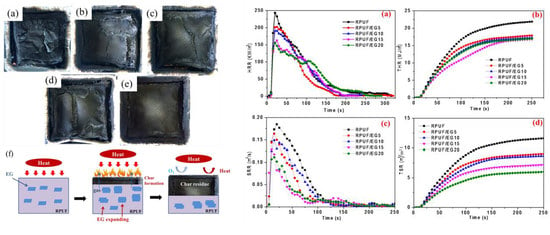Structure and Flame-Retardant Actions of Rigid Polyurethane Foams with Expandable Graphite
Abstract
:1. Introduction
2. Experimental
2.1. Materials
2.2. Preparation of Rigid Polyurethane Foams (RPUF) with Expandable Graphite
2.3. Characterization
3. Results and Discussion
3.1. Microstructures of Foam
3.2. Compression Strength
3.3. LOI Tests
3.4. Cone Calorimeter
3.5. TGA-FTIR Analysis of RPUF/EG Samples
3.6. Macro Morphology of Residues from Cone Calorimeter
3.7. XPS Analysis of Residues from Cone Calorimeter
4. Conclusions
Author Contributions
Funding
Conflicts of Interest
References
- Ye, L.; Meng, X.; Ji, X.; Tang, J. Synthesis and characterization of expandable graphite–poly(methyl methacrylate) composite particles and their application to flame retardation of rigid polyurethane foams. Polym. Degrad. Stab. 2009, 94, 971–979. [Google Scholar] [CrossRef]
- Thirumal, M.; Khastgir, D.; Singha, N.; Manjunath, B.; Naik, Y. Effect of foam density on the properties of water blown rigid polyurethane foam. J. Appl. Polym. Sci. 2010, 108, 1810–1817. [Google Scholar] [CrossRef]
- Li, C.; Hui, B.; Ye, L. Highly reinforcing and thermal stabilizing effect of imide structure on polyurethane foam. Polym. Int. 2019, 68, 464–472. [Google Scholar] [CrossRef]
- Hatchett, D.; Kodippili, G.; Kinyanjui, J.; Benincasa, F.; Sapochak, L. FTIR analysis of thermally processed PU foam. Polym. Degrad. Stab. 2005, 87, 555–561. [Google Scholar] [CrossRef]
- Lefebvre, J.; Bastin, B.; Bras, M.; Duquesne, S.; Paleja, R.; Delobel, R. Thermal stability and fire properties of conventional flexible polyurethane foam formulations. Polym. Degrad. Stab. 2005, 88, 28–34. [Google Scholar] [CrossRef]
- Shi, X.; Jiang, S.; Zhu, J.; Li, G.; Peng, X. Establishment of a highly efficient flame-retardant system for rigid polyurethane foams based on bi-phase flame-retardant actions. RSC Adv. 2018, 8, 9985–9995. [Google Scholar] [CrossRef]
- Du, M.; Guo, B.; Jia, D. Thermal stability and flame retardant effects of halloysite nanotubes on poly(propylene). Eur. Polym. J. 2006, 42, 1362–1369. [Google Scholar] [CrossRef]
- Rao, W.; Xu, H.; Xu, Y.; Qi, M.; Liao, W.; Xu, S.; Wang, Y. Persistently flame-retardant flexible polyurethane foams by a novel phosphorus-containing polyol. Chem. Eng. J. 2018, 343, 198–206. [Google Scholar] [CrossRef]
- Wazarkar, K.; Kathalewar, M.; Sabnis, A. Improvement in flame retardancy of polyurethane dispersions by newer reactive flame retardant. Prog. Org. Coat. 2015, 87, 75–82. [Google Scholar] [CrossRef]
- Chen, X.; Huang, Z.; Xi, X.; Li, J.; Fan, X.; Wang, Z. Synergistic effect of carbon and phosphorus flame retardants in rigid polyurethane foams. Fire Mater. 2018, 42, 447–453. [Google Scholar] [CrossRef]
- Wang, C.; Wu, Y.; Li, Y.; Shao, Q.; Yan, X.; Han, C.; Wang, Z.; Liu, Z.; Guo, Z. Flame-retardant rigid polyurethane foam with a phosphorus-nitrogen single intumescent flame retardant. Polym. Advan. Technol. 2018, 29, 668–676. [Google Scholar] [CrossRef]
- Hong, G.; Gao, Q.; Ouyang, C.; Zheng, K.; Wei, X. Research on properties of rigid polyurethane foam with heteroaromatic and brominated benzyl polyols. J. Appl. Polym. Sci. 2015, 132, 42349. [Google Scholar] [CrossRef]
- Casetta, M.; Michaux, G.; Ohl, B.; Duquesne, S.; Bourbigot, S. Key role of magnesium hydroxide surface treatment in the flame retardancy of glass fiber reinforced polyamide 6. Polym. Degrad. Stab. 2018, 148, 95–103. [Google Scholar] [CrossRef]
- Wang, Y.; Wang, F.; Dong, Q.; Xie, M.; Liu, P.; Ding, Y.; Zhang, S.; Yang, M.; Zheng, G. Core-shell expandable graphite @ aluminum hydroxide as a flame-retardant for rigid polyurethane foams. Polym. Degrad. Stab. 2017, 146, 267–276. [Google Scholar] [CrossRef]
- Qian, L.; Feng, F.; Tang, S. Bi-phase flame-retardant effect of hexa-phenoxy-cyclotriphosphazene on rigid polyurethane foams containing expandable graphite. Polymer 2014, 55, 95–101. [Google Scholar] [CrossRef]
- Singh, H.; Jain, A.; Sharma, T. Effect of phosphorus-nitrogen additives on fire retardancy of rigid polyurethane foams. J. Appl. Polym. Sci. 2010, 109, 2718–2728. [Google Scholar] [CrossRef]
- Gao, L.; Zheng, G.; Zhou, Y.; Hu, L.; Feng, G.; Xie, Y. Synergistic effect of expandable graphite, melamine polyphosphate and layered double hydroxide on improving the fire behavior of rosin-based rigid polyurethane foam. Ind. Crop. Prod. 2013, 50, 638–647. [Google Scholar] [CrossRef]
- Bian, X.; Tang, J.; Li, Z. Flame retardancy of hollow glass microsphere/rigid polyurethane foams in the presence of expandable graphite. J. Appl. Polym. Sci. 2010, 109, 1935–1943. [Google Scholar] [CrossRef]
- Cheng, J.; Qu, W.; Sun, S. Mechanical properties improvement and fire hazard reduction of expandable graphite microencapsulated in rigid polyurethane foams. Polym. Compos. 2018. [Google Scholar] [CrossRef]
- Gogoi, P.; Boruah, M.; Bora, C.; Dolui, S. Jatropha curcas oil based alkyd/epoxy resin/expanded graphite (EG) reinforced bio-composite: Evaluation of the thermal, mechanical and flame retardancy properties. Prog. Org. Coat. 2014, 77, 87–93. [Google Scholar] [CrossRef]
- Zheng, Z.; Liu, Y.; Zhang, L.; Wang, H. Synergistic effect of expandable graphite and intumescent flame retardants on the flame retardancy and thermal stability of polypropylene. J. Mater. Sci. 2016, 51, 5857–5871. [Google Scholar] [CrossRef]
- Khalili, P.; Tshai, K.; Kong, I. Natural fiber reinforced expandable graphite filled composites: Evaluation of the flame retardancy, thermal and mechanical performances. Compos. Part A Appl. S. 2017, 100, 194–205. [Google Scholar] [CrossRef]
- Gama, N.; Costa, L.; Amaral, V.; Ferreira, A.; Barros-Timmons, A. Insights into the physical properties of biobased polyurethane/expanded graphite composite foams. Compos. Sci. Technol. 2017, 138, 24–31. [Google Scholar] [CrossRef]
- Shi, L.; Li, Z.; Xie, B.; Wang, J.; Tian, C.; Yang, M. Flame retardancy of different-sized expandable graphite particles for high-density rigid polyurethane foams. Polym. Int. 2010, 55, 862–871. [Google Scholar] [CrossRef]
- Modesti, M.; Lorenzetti, A. Halogen-free flame retardants for polymeric foams. Polym. Degrad. Stab. 2002, 78, 167–173. [Google Scholar] [CrossRef]
- Gao, M.; Wu, W.; Liu, S.; Wang, Y.; Shen, T. Thermal degradation and flame retardancy of rigid polyurethane foams containing a novel intumescent flame retardant. J. Therm. Anal. Calorim. 2014, 117, 1419–1425. [Google Scholar] [CrossRef]
- Li, X.; Cao, H.; Zhang, Y. Thermal degradation kinetics of rigid polyurethane foams blown with water. J. Appl. Polym. Sci. 2006, 102, 4149–4156. [Google Scholar] [CrossRef]
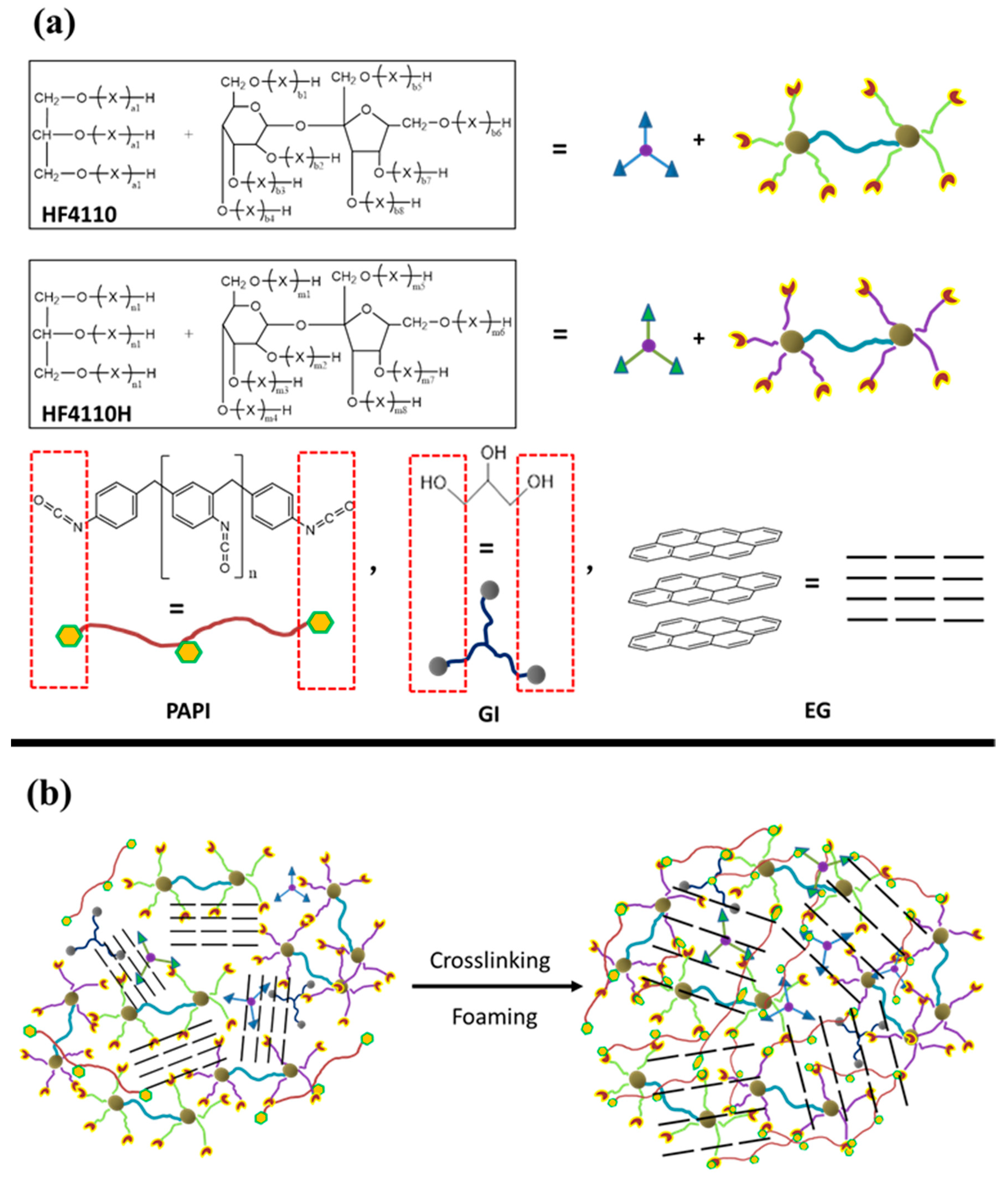



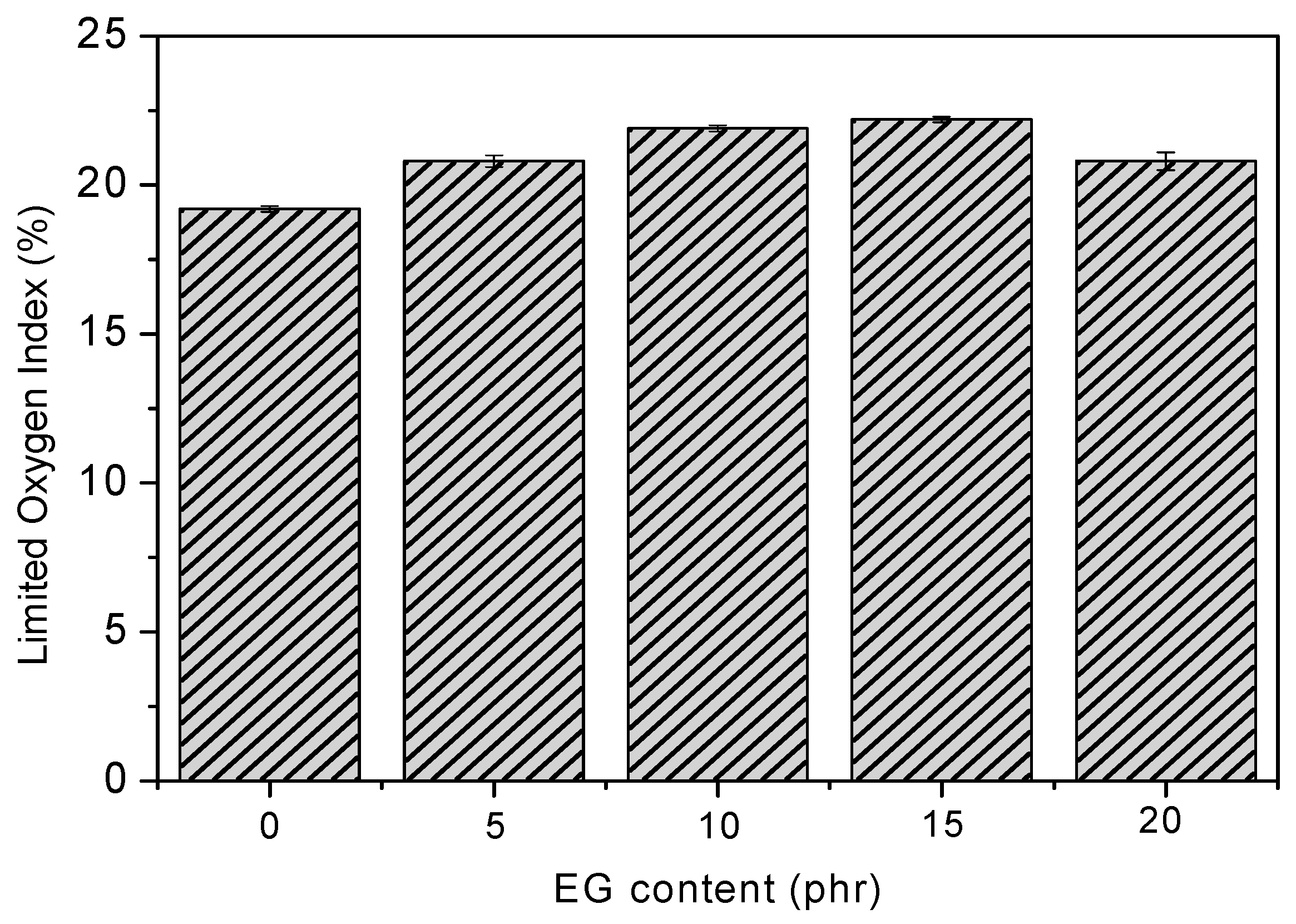
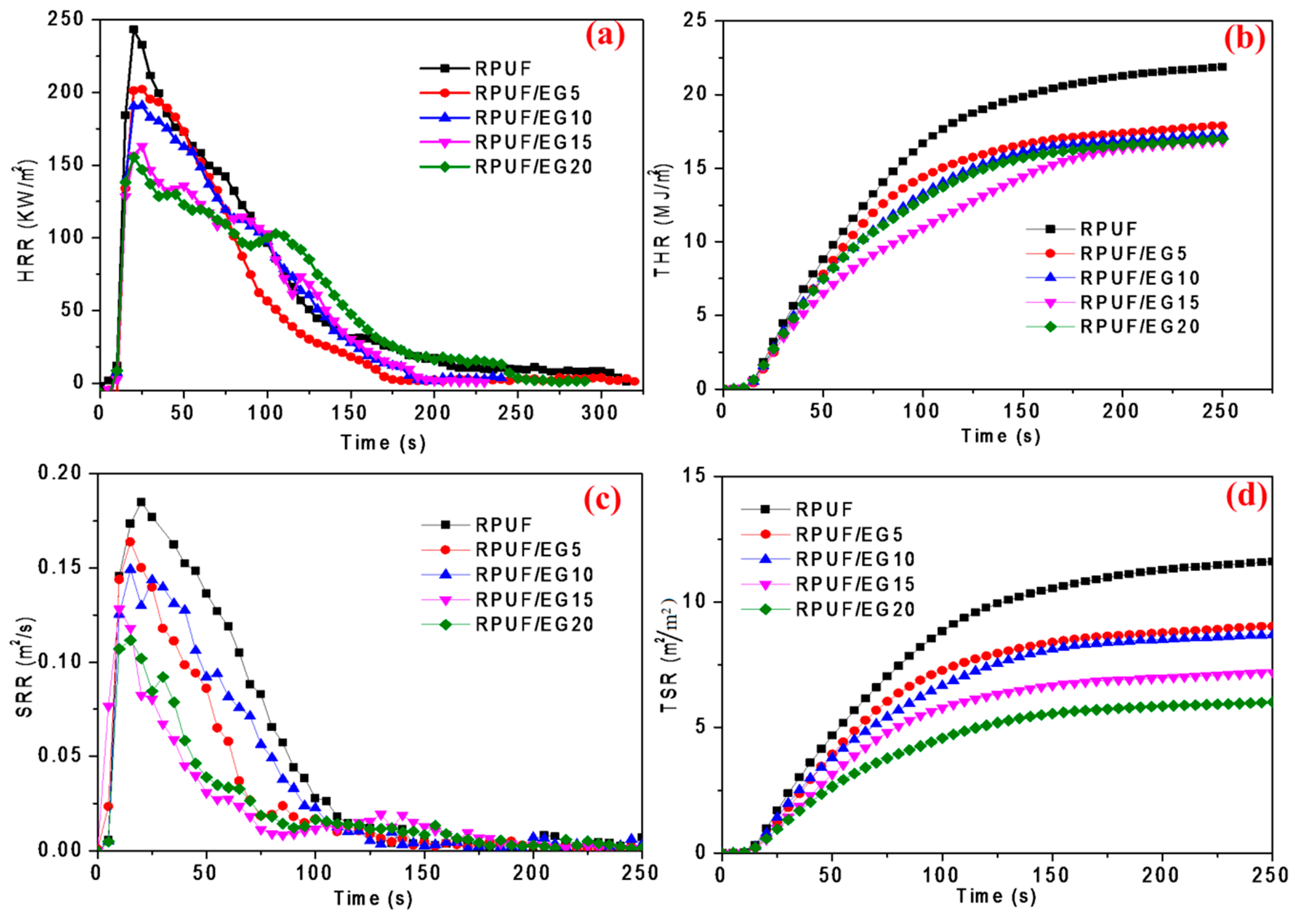

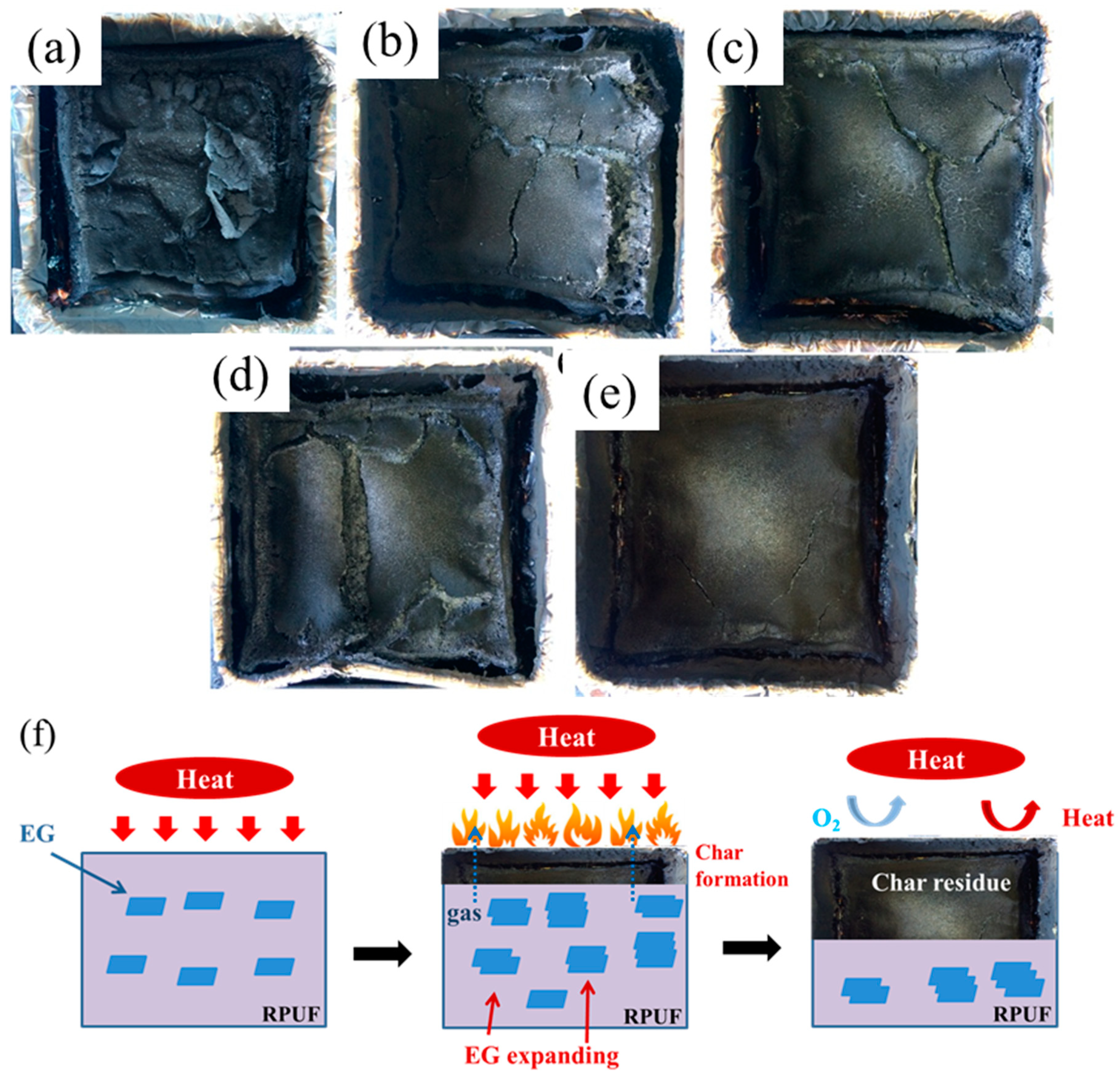
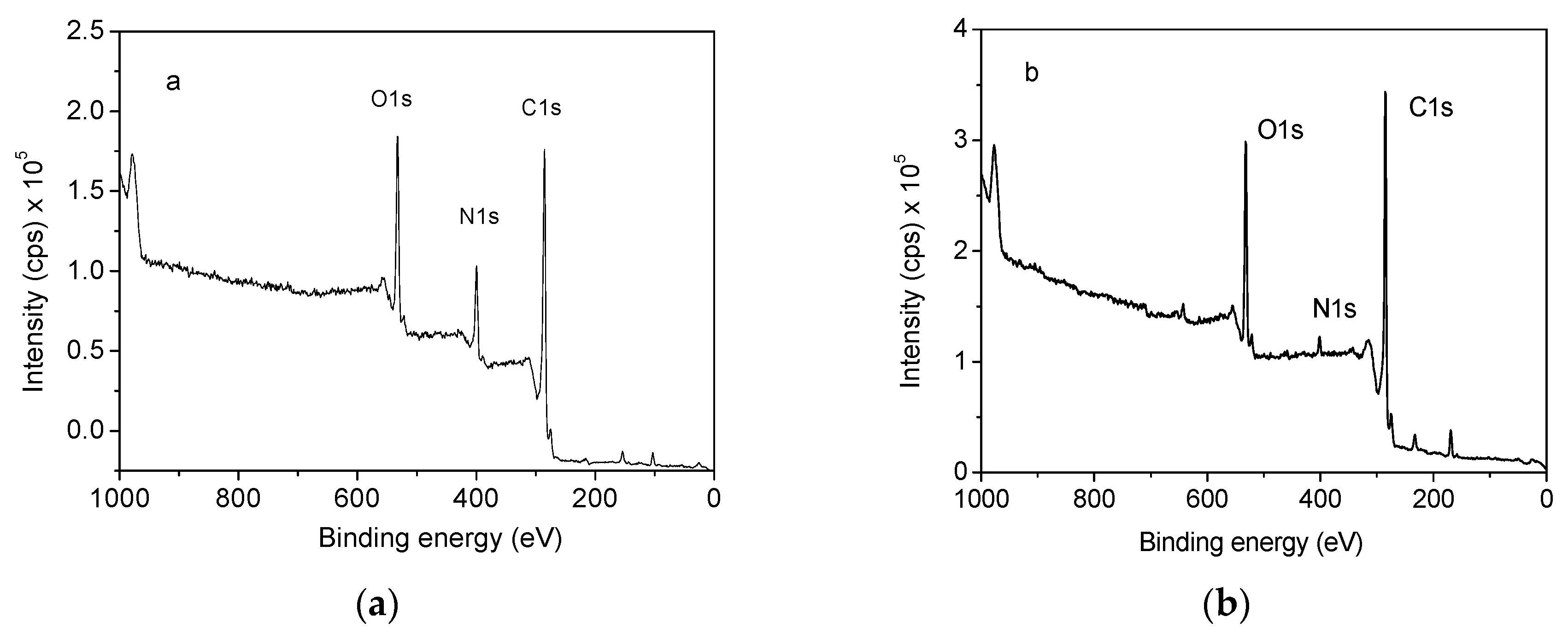
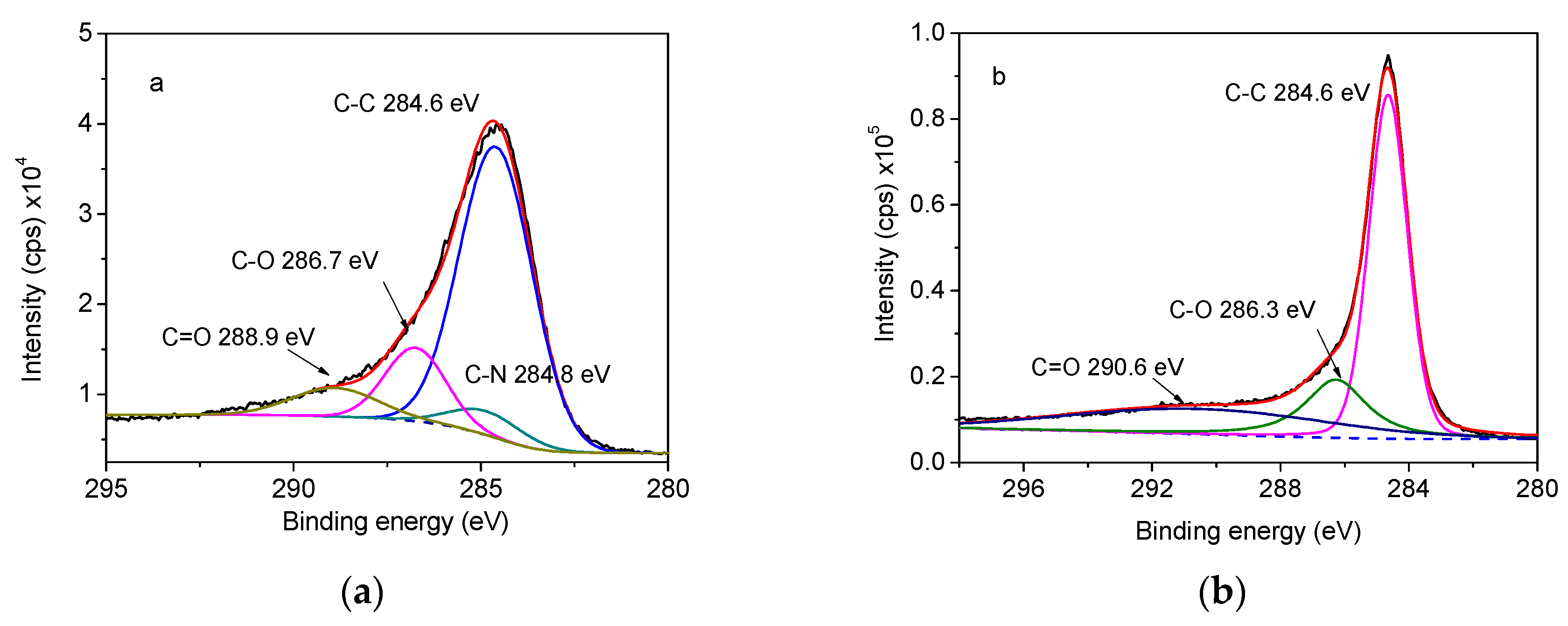
| Sample | RPUF (phr) | RPUF/EG5 (phr) | RPUF/EG10 (phr) | RPUF/EG15 (phr) | RPUF/EG20 (phr) |
|---|---|---|---|---|---|
| HF-4110H | 70 | 70 | 70 | 70 | 70 |
| HF-4110 | 30 | 30 | 30 | 30 | 30 |
| H2O | 3 | 3 | 3 | 3 | 3 |
| AK-8805 | 2 | 2 | 2 | 2 | 2 |
| A33 | 2 | 2 | 2 | 2 | 2 |
| GI | 1.0 | 1.0 | 1.0 | 1.0 | 1.0 |
| PAPI | 138 | 138 | 138 | 138 | 138 |
| EG | 0 | 5 | 10 | 15 | 20 |
| Samples | TTI (s) | PHRR (kW/m2) | THR (MJ/m2) | TSR (m2/m2) |
|---|---|---|---|---|
| RPUF | 4 | 243 | 21.8 | 11.6 |
| RPUF/EG5 | 5 | 202 | 17.8 | 9.0 |
| RPUF/EG10 | 6 | 190 | 17.3 | 8.8 |
| RPUF/EG15 | 6 | 163 | 16.8 | 7.2 |
| RPUF/EG20 | 5 | 155 | 17.0 | 6.0 |
| Property | RPUF | RPUF/EG5 | RPUF/EG10 | RPUF/EG15 | RPUF/EG20 |
|---|---|---|---|---|---|
| temperature at 5% mass loss/°C | 196.5 | 182.3 | 173.8 | 167.3 | 160.6 |
| temperature at 10% mass loss/°C | 249.8 | 249.8 | 236.3 | 227.3 | 215.6 |
| temperature at 50% mass loss/°C | 364.8 | 347.3 | 353.8 | 354.8 | 350.6 |
| onset degradation temperature/°C | 180.0 | 163.6 | 155.4 | 145.0 | 139.2 |
| temperature at maximum mass loss rate/°C | 356.5 | 340.0 | 342.5 | 345.0 | 341.8 |
| residual percentage/% | 17.5 | 18.2 | 17.3 | 16.7 | 16.6 |
| Identification | RPUF | RPUF/EG20 | ||
|---|---|---|---|---|
| BE(eV) | A(%) | BE(eV) | A(%) | |
| C-C | 284.6 | 49.1 | 284.6 | 51.4 |
| C-N | 284.8 | 6.4 | — | — |
| C-O | 286.7 | 31.9 | 286.2 | 12.4 |
| C(O)O | 288.9 | 13.6 | 289.6 | 36.2 |
© 2019 by the authors. Licensee MDPI, Basel, Switzerland. This article is an open access article distributed under the terms and conditions of the Creative Commons Attribution (CC BY) license (http://creativecommons.org/licenses/by/4.0/).
Share and Cite
Chen, Y.; Luo, Y.; Guo, X.; Chen, L.; Xu, T.; Jia, D. Structure and Flame-Retardant Actions of Rigid Polyurethane Foams with Expandable Graphite. Polymers 2019, 11, 686. https://doi.org/10.3390/polym11040686
Chen Y, Luo Y, Guo X, Chen L, Xu T, Jia D. Structure and Flame-Retardant Actions of Rigid Polyurethane Foams with Expandable Graphite. Polymers. 2019; 11(4):686. https://doi.org/10.3390/polym11040686
Chicago/Turabian StyleChen, Yongjun, Yuanfang Luo, Xiaohui Guo, Lijuan Chen, Tiwen Xu, and Demin Jia. 2019. "Structure and Flame-Retardant Actions of Rigid Polyurethane Foams with Expandable Graphite" Polymers 11, no. 4: 686. https://doi.org/10.3390/polym11040686
APA StyleChen, Y., Luo, Y., Guo, X., Chen, L., Xu, T., & Jia, D. (2019). Structure and Flame-Retardant Actions of Rigid Polyurethane Foams with Expandable Graphite. Polymers, 11(4), 686. https://doi.org/10.3390/polym11040686



